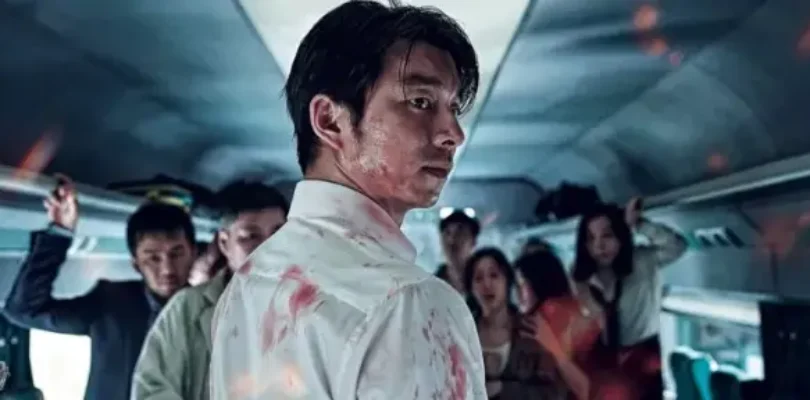Welcome back to the scariest, and at times goriest, column here at Film Inquiry: Horrific Inquiry. Each month, I will be tackling all things horror, bringing two films back into the spotlight to terrify and frighten once more. And occasionally looking at those that could have pushed the envelope further. Join us as we dive deep into the heart of horror, but warning, there will be spoilers.
Zombies have horrified and amazed audiences for decades. There is an irresistible allure to the all-consuming end of mankind. So much so books, television series and film have brought to life the unyielding need to expand our imagination and even prepare for the unlikely rise of the living dead. Yet, with each induction, the confines of definition expand, small tweaks to the lore and mythology of the zombie elevating it in both terror and ingenuity. Nothing truer could be said for Yeon Sang-ho‘s Train to Busan.
Train to Busan follows the growing trend of zombies with super strength and impossible speed. Yet, as it leans into the growing evolution of the zombie, it adds its own horrific innovations as well. Train to Busan finds its success within the power and force of nature, its zombies seemingly indestructible. There is no chance of survival by destroying the head, no cloaking virus to hide its prey. The zombies of Train to Busan are the evolution of nature at its finest, incorporating the fluidity and destruction of one of its most powerful elements – water.
But Sang-ho does not just find its success in the terror of its living dead evolution, but also in the complexity of the father-daughter relationship. Train to Busan is as cathartic as it is terrifying, embracing the human and cultural motive of sacrifice while leaving its audience in a fully realized moment of catharsis. By film’s end, it is not just the horror that will remain, but the experience as well.
Defying Expectations Early On
Train to Busan opens where one would expect – a quarantine zone. As a truck pulls up to a man in a biohazard suit, there is an expectation that begins to settle in the pit of our stomachs, the downfall and terror to come pinpointed to this one moment of human error. We expect push back from the man in the biohazard suit, refusal to let the man in the truck move along to his destination. We also retain the expectation that he is not stopped, the infection quietly hidden away with the man leaving the quarantine zone. To our surprise, the scene plays out innocuously, small conversation leading to neither conflict nor clues to a potential down fall.
As the truck departs and makes its way down the street, our first jump scare is delivered, a deer jumping out into the road and being hit by the truck. I would be lying if I didn’t admit I had expected the man to have hit the first zombie of the film, a bite being the catalyst for the impending destruction. This assumption, both here and in the opening moments, speaks to the expectations audiences have cultivated over the decades. Train to Busan shows early on that it is aware of the history, willingly toying with its audiences’ expectations and working early on to identify its own individuality.
As the man exits his truck to see what he hit, he sees it was only a deer. As the truck departs, the body of the deer begins to twitch, Train to Busan once again defies expectations as the deer comes back to life. In this moment, there is a fully realized understanding that the virus is not spread from human to human, rather is an all-consuming force of nature that knows no limits. While the event itself has its roots in the hubris of man, it feels fueled by nature in every facet. As the virus quickly spreads in the periphery, this understanding that a bite is not restricted to a human adds to the authenticity to the rate of spread and the breadth it is able to reach so quickly.
Peripheral Infection
This opening realization is terrifying, yet the film does not linger on the moment. Rather, it moves us directly to our central protagonist Seok-woo (Gong Yoo). A hedge fund manager, he is depicted not only losing a recent bet, but risking it all on a new one. The scene feels like basic character building, a simplistic introduction too often seen in horror films. Yet, as we are introduced to his daughter Soo-an (Kim Su-an), we slowly begin to understand a family dynamic that revolves around this job, rather than the family at hand. As we learn, Seok-woo is in the middle of a custody battle with his ex-wife, his daughter’s demand to see her mother for her birthday only putting a further strain on both job and disintegrating relationships.

As we see the fractures and perceived failures between father and daughter, we also begin to create an understanding of sacrifice and love. As Seok-woo yields to his daughter’s continued desire to spend her birthday with her mother in Busan, our film begins to move our characters into the heart of the film – and the heart of disaster. This once again becomes evidence to the awareness of the filmmakers as the camera stays focused on father and daughter as they make their way to the train. The impending disaster stays just on the periphery, never front and center. A mass of emergency vehicles narrowly misses them, buildings are on fire on the other side of the city while the initial attack at the train station stays just beyond our vision at the top of the stairs.
It heightens the tension. We know the attack and the reveal is coming, and we know when it does, it will be too late for those on train. Yet Train to Busan does not want to meet our expectations on our demand, rather willing to keep an even pace to its epic reveal. As the conductor makes the final boarding call, screams are heard above the stairs, bodies seemingly falling to the ground. A girl races on to the train, clearly distraught – clearly injured. As the train begins to move, it continues to utilize the terror on the periphery, people on the platform starting to run as a zombie is seen jumping on a waiting passenger. It is brief, blurred – a moment where you find yourself questioning what you saw.

As the train departs, Train to Busan transitions the periphery to the forefront – taking one last moment to toy with its audience once more. We know an infected girl has made it on to the train unseen. We know the impending aftermath. Yet, as the train attendants try to open the bathroom that houses a potential stowaway, the tension rises as we expect the now fully infected girl to lunge out and become the catalyst for the rest of the film. However, our held breaths are left unrewarded, and the last bit of periphery infection plays out, a man in the bath room, terrified – “all dead… everyone”. It adds to the building tension of the fully unseen infection, the man appearing crazy in the absence of full sight. Rather, he is the final warning as the train leaves the station and the infection fully takes over the girl.
Death Does Not Come for the Undead
One of the best aspects of Train to Busan are the zombies themselves. While this would be expected from a film about zombies, there is a fluidity to the undead that elevates from depictions that have come before. There is also a rapid movement that heightens the intensity, making it near impossible to outrun them. The zombies feel more super human than ever before, not just in movement but in the predatory aspects of their nature. Their hearing is unfounded and sight undeniable. It is not just movement, but the actual recognition of a human – of the meal.
Equally scary – they seem to never die. Eternally the living dead, nothing seems to stop them. Preventing them from eating yes, but never from moving – and never from existing. This adds to the darkness of Train to Busan, a depressive and terrifying weight added in the sense that resistance may be futile – that there is no defeating the nature of the end.

Yet, what I found equally hypnotic and terrifying was their movement. I couldn’t help seeing their movement and many times unity, as one of the most powerful forces of nature – water. Fast, unstoppable and overwhelming destructive, water is a force of nature that knows no boundaries and no limits. One of my favorite scenes in Train to Busan falls towards the end of the film following a train crash. With zombies pressed against the glass of an overturned train, fractures begin to form throughout the window. As they finally give way, zombies pour through the windows of a train mirroring the fluidity of broken glass in an aquarium. With the zombies pouring out, for a moment it felt as though I was watching an underwater horror film basked in the unrelenting power of natural destruction. While this was one of my favorite moments in the film, the fluidity is not restricted to the end of the film. This movement is seen earlier too, as the zombies pile over one another in the cramped space of the train to eat others, their movement mirroring water flowing rapidly through a pipe.
While the rise of zombies could be seen as an element of natural balance, Train to Busan truly embraces the natural power of their creation, absorbing elements of nature into every aspect of their terror.
The Catharsis of the Father-Daughter Relationship
An outstanding aspect of Train to Busan is the depth it is willing to go to tackle the fractured father-daughter relationship. First and foremost, this is a horror film, zombies, blood and ripped guts littering scenes almost every chance the filmmakers get. Yet, the film never forgets the horror surrounding the possibility of never rectifying the fractures within a relationship.

Train to Busan spends time layering these fractures – missing school shows, regifting previous gifts, attempts to instill selfishness in the wake of kindness. Absence and misunderstandings become the root of these fractures, ones audiences find many times are lost in sacrifice. We see the horror of consequence in the face of sacrifice – whether it be for the betterment of others or self. As the zombies begin to take over the train, as well as the surrounding areas, the relationship between father-daughter is truly tested and shown for its faults. Yet in the horror of sacrifice, we are delivered a catharsis in its greatest moment.
With each encounter with the zombies, Seok-woo fully becomes the realization of selflessness and sacrifice. As they outrun the zombies at the train yard and board the train that will take them to a hopeful salvation, Seok-woo must fight one last zombie before safety can be guaranteed for his daughter and Seong-kyeong (Jung Yu-mi). Yet, in the fight, he is bitten and his fate is sealed. Knowing time is limited before he turns, Seok-woo says a final farewell to his daughter before making his way back to the train. As his daughter is heard and shown screaming for her father, Seok-woo accepts his fate, his final moments of life capturing the beauty of his daughter. Our final view of him just before he turns captures the joy of these memories and the joy of the sacrifice he is about to make to ensure her safety. While the virus has consumed him, his cloudy eyes indicating his time has run out, a smile spreads across his face. The camera moves to the train’s shadow on the tracks, captures his shadow as well as it falls from the train to the tracks below. Arguably one of the most cathartic moments in cinema, Train to Busan delivers, in the face of an indestructible horror, the human capacity to love, sacrifice and retain hope until our final breath.
Conclusion
Train to Busan works to capture the devastation of loss in an incomprehensible situation, the immediacy of devastation and its various forms of manifest – a son who hears the final breath of his mother, the sister who loses her other half, the player who loses his friends, the wife and child who lose a father. This is not just a zombie film, but a horrifically beautiful cathartic journey of release. Working up to its final moments, Train to Busan is a thing of poetry, a life realized in the face of finality. The sacrifice of life proves itself worthy through the strength of resilience
While it also tackles greed in the need for survival, in its big picture, it is the human experience of emotion coupled with its unrelenting need to fight. There is a deep love that carries through the devastation, Train to Busan delivers what movies are all about.
Does content like this matter to you?
Become a Member and support film journalism. Unlock access to all of Film Inquiry`s great articles. Join a community of like-minded readers who are passionate about cinema – get access to our private members Network, give back to independent filmmakers, and more.




